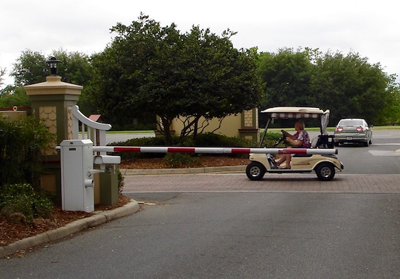The Cutting Edge of New Urban Transport
The Cutting Edge of New Urban Transport Paradigms Based on Innovations in Gated Community Mobility
Once you leave the well-kept, well-organized confines of your gated community and venture into the world beyond (which you were happy to leave in the first place), it is highly likely you will be again back in the rough-and-tumble of traffic congestion and those aggravating, unexpected delays in getting to your destination. When you think about it, one of the delightful benefits of residing in a planned community is continuity and predictability of its transport system. These benefits are a function of the well laid-out roadway infrastructure and the kind of vehicle most people use—that is, our beloved personal transportation vehicle.
Bear with me as I process a few factoids about cities and urban transport, and how our gated communities and their transportation systems could serve as a model for much larger cities. Having done that, I have points to make regarding the implications for personal mobility and traffic management as relates to personal transportation vehicle (PTV) manufacturers.
Urban transport systems are much in the news. At least it’s not difficult to find such news. Simply put “new urban transport systems” in your browser and you will see what I mean. Leading consulting heavyweights such as Deloitte and McKinsey are vying for prominence in the rapidly emerging field of integrated urban transport systems and so-called smart cities.
And well might these renown think tanks entertain such a focus. Across the globe urban centers are rapidly growing, especially in developing economies. According to the Ask Anything website, which has compiled population statistics of various sorts, 15 of the 20 cities of the world with populations over 10 million are in developing economies and 5 developed countries. The United States has 9 cities over 1 million population, while China has a whopping 99.
The fact that there are, throughout the world, so many significantly large urban centers, coupled with the fact that most are steadily growing larger, makes it clear why so much emphasis is being placed on urban mobility, transportation infrastructure, and transport-related information and management systems.
Gated communities as a model
A gated community is a planned community, and in general, they are planned for what one could call, “efficient living”. Take The Villages in Florida, for example. Note that the noun “Villages” is plural, and, indeed, this community is comprised of a series of village centers with domiciles clustered around each center. Each center has restaurants, a theatre, a bank, a food mart, a recreation facility (in addition to golf), and various retail outlets. So far, the description would fit various large cities in the United States, which have developed neighborhoods with similar amenities.
Where the differences come in is in mobility, getting from point A to point B. And these differences are huge. The typical urban center is congested, has poor air quality, and the center itself may be at a considerable distance from the homes it services.
Contrast this to a gated community, where mobility is conveniently afforded by personal transportation vehicles (PTVs), which a small, yet quite accommodating for shopping, travel to gym or pool, trips to the grocery store, and so on. As to pollution and congestion, these issues are minimized.
Mobilizing for the future—what vehicle types will best the needs for mobility?
While gated communities offer worlds of efficiency compared with a typical city center, that efficiency centered around mobility, both stand to improve their environment via a concept rapidly gaining traction globally. That concept is “mobility as a service”, or MaaS, as it is acronymized. This is a concept of mobility that goes beyond (but does not exclude) individual vehicle ownership. Public transportation is a form of MaaS–nothing new in this–but other concepts are, such a ride sharing, on-call mobility, and shuttles. Closely tied to the various versions of MaaS is autonomous vehicle technology.
Driverless shuttles are being currently tested on college campuses and could fit well in the mobility environment of a gated community. LM Industries (stands for Local Mobility) has designed and is testing a self-driving shuttle called Olli. Using a LIDAR sensor and an integrated software/actuator system, which responds to road conditions and is the heart of the self-driving experience, the Olli is beyond simple to use. Via an app, you can register, book, ride, and pay. Book a ride in the Modally App and await the nearest OLLI to pick you up and transport you to your destination.
LM Industries recently signed an agreement to use and develop in-wheel electric motors, designed by Proteon Electric. Protean Electric has designed and developed a unique in-wheel electric drive system for hybrid, plug-in hybrid and battery electric light-duty vehicles. The Protean Drive® system can improve vehicle fuel economy, add torque, increase power and enable improved vehicle handling to both new and existing vehicles.
I cite this example of new technologies that can potentially refine and enhance mobility in a gated community and, eventually, a metropolis like New York or Atlanta. And what better place to test and commercially operate this technology than a gated community?
The fact is that autonomous vehicle technology is exploding, virtually all of it the product of start-up teams of young, electronics, software, and mechanical engineers. And these start-ups are being acquired right and left by the big boys in the automotive field from vehicle manufacturers to major parts and components suppliers.
What about golf cars (particularly PTVs) and light portage and transport derivatives?
Product advances in this industry are painfully incremental, speaking of golf cars and their derivatives. Truth be told (you are free to disagree with me), there has been more new product development by independent parts and components suppliers to the golf car industry than by the golf car manufacturers themselves. While this article features a shuttle application, the technological advances cited are quite adaptable to PTVs, whether in an on-call fleet operated by the gated community as a public service, or as individually-owned vehicles.
But I don’t expect these innovations to come from Club Car, Yamaha, or E-Z-GO Textron. It will be the start-ups, the innovators, that may well source their vehicle component from the Big Three, but then renovate that component in what would be a radical makeover in the technology and mode of use for small vehicles in the gated community.
Contact the Author: Steve Metzger at smetzger@smallvehicleresource.com. Or check out our website at www.smallvehicleresource.com, where you will find an extensive database of vehicle models and can make side-by-side comparisons of vehicles based on a full set of specifications.



